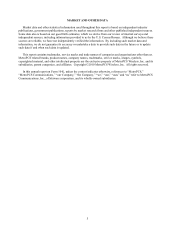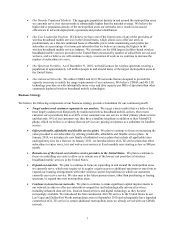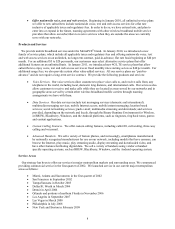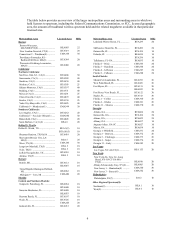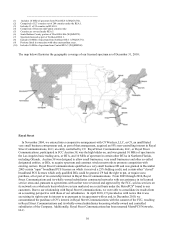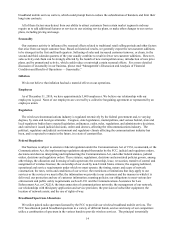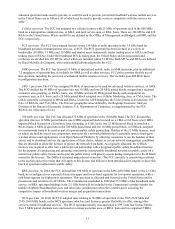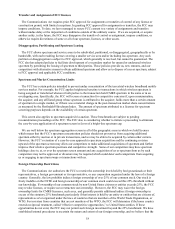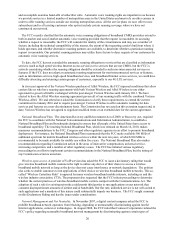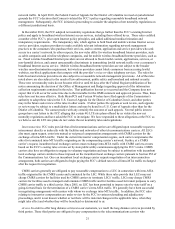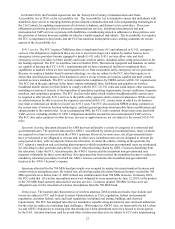Metro PCS 2010 Annual Report Download - page 25
Download and view the complete annual report
Please find page 25 of the 2010 Metro PCS annual report below. You can navigate through the pages in the report by either clicking on the pages listed below, or by using the keyword search tool below to find specific information within the annual report. 15
allocated spectrum bands used to provide, or could be used to provide, terrestrial broadband wireless mobile services
in the United States are as follows, all of which can be used to provide services competitive with the services we
offer:
Cellular spectrum. The FCC has assigned two cellular licenses with 25 MHz of spectrum each in the 800 MHz
band on a metropolitan statistical area, or MSA, and rural service area, or RSA, basis. There are 306 MSAs and 428
RSAs in the United States. MSAs and RSAs are defined by the Office of Management and Budget, or OMB, and the
FCC, respectively.
PCS spectrum. The FCC has assigned licenses to use 130 MHz of radio spectrum in the 1.9 GHz band for
broadband personal communications services, or PCS. The PCS spectrum has been licensed in a variety of
bandwidths (30 MHz, 15 MHz and 10 MHz) and market areas (nationwide, major trading areas or MTAs and basic
trading areas or BTAs). Under the broadband PCS licensing plan, the United States and its possessions and
territories are divided into 493 BTAs, all of which are included within 51 MTAs. Both MTAs and BTAs are defined
by Rand McNally & Company, with certain modifications adopted by the FCC.
SMR spectrum. The FCC has licensed 19 MHz of specialized mobile radio, or SMR spectrum, plus an additional
7.5 megahertz of spectrum that is available for SMR as well as other services. FCC policy permits flexible use of
this spectrum, including the provision of enhanced mobile wireless services. This includes post-800 MHz band
reconfiguration spectrum.
AWS-1 spectrum. The FCC has assigned 90 MHz of spectrum to be used for advanced wireless services, or AWS.
The FCC divided the 90 MHz of spectrum into two 10 MHz and one 20 MHz paired blocks assigned on a regional
economic area grouping, or REAG, basis; one 10 MHz and one 20 MHz paired blocks each assigned on an
economic area, or EA, basis; and a 20 MHz paired block assigned on a Cellular Marketing Area, or CMA, basis. The
CMAs generally correspond to MSAs and RSAs. Under the AWS band plan, the United States is divided into 176
EAs, 12 REAGs, and 734 CMAs. The EAs are geographic areas defined by the Regional Economic Analysis
Division of the Bureau of Economic Analysis, U.S. Department of Commerce, as supplemented by the FCC.
REAGs are collections of EAs.
700 MHz spectrum. The FCC has allocated 72 MHz of spectrum in the 700 MHz band. The FCC divided this
spectrum into two 12 MHz paired blocks, one 6 MHz unpaired block licensed on a CMA or EA basis; one 6 MHz
unpaired block licensed on a Economic Area Grouping, or EAG, basis; one 22 MHz paired block licensed on a
REAG basis, 4 MHz of spectrum in the 700 MHz guard band and one 10 MHz paired block, or D Block, assigned
on a nationwide basis to be used as part of a private/public safety partnership. Holders of the 22 MHz licenses, most
of which are held by one of our competitors, must provide a network platform that is generally open to third-party
wireless devices and applications, or an Open Network Platform, by allowing consumers to use the handset of their
choice and to download and use the applications of their choice, subject to certain network management conditions
that are intended to allow the licensee to protect the network from harm. As originally allocated, the D Block
licensee was required to enter into a public/private partnership with a designated public safety broadband licensee
for the purpose of constructing and operating a nationwide interoperable broadband network for public safety on a
nationwide public safety license and to provide public safety with priority access during emergencies to the D Block
owned by the licensee. The D Block remained unpurchased at auction. The FCC currently is considering revisions
to the auction and service rules that will apply to this license and bills have been introduced in Congress to have this
block of spectrum reallocated to public safety.
BRS spectrum. In 2004, the FCC ordered that 194 MHz of spectrum in the 2496-2690 MHz band, or the 2.5 GHz
band, be reconfigured over a period of time into upper and lower-band segments for low-power operations, with a
mid-band segment for high-power operations. This spectrum is allocated and licensed in the United States and its
possessions and territories in 493 BTAs. The Commission concluded in 2008 that 55.5 MHz of the broadband radio
service, or BRS, spectrum holdings in the 2.5 GHz band will be included in the Commission’s product market for
mobile telephony/broadband services, and taken into consideration when the Commission is assessing the
competitive impact of broadband wireless merger and acquisition transactions.
WCS spectrum. In 2010, the FCC adopted rules relating to 30 MHz of spectrum in the 2305-2320 MHz and
2345-2360 MHz bands, or the WCS spectrum, which accord licensees greater flexibility to offer, among other
services, mobile broadband services. The WCS spectrum initially was auctioned in 1997 into four license blocks.
Two 5 MHz paired channels were auctioned on a major economic area, or MEA, basis and two unpaired 5 MHz


